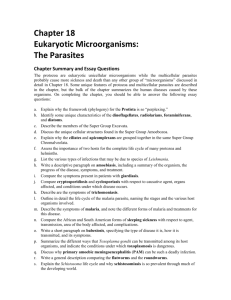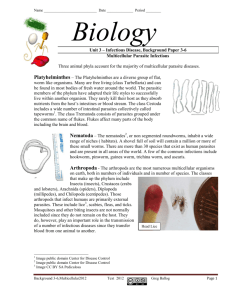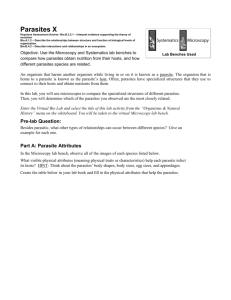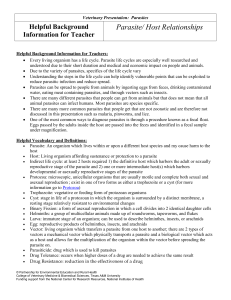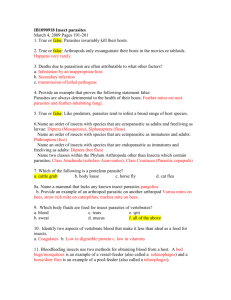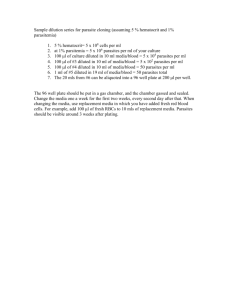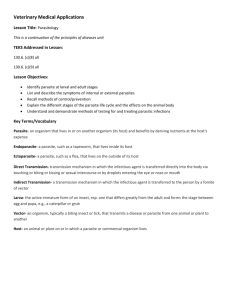Introduction in medical parasitology and parasitic diseases
advertisement
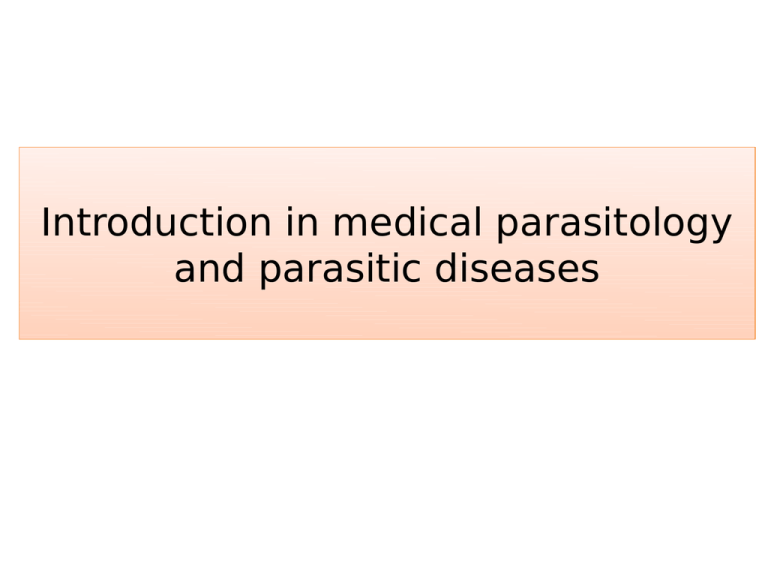
Introduction in medical parasitology and parasitic diseases Medical (human) parasitology • Human parasitology is the study of those organisms which parasitise humans • According to the very broad definition of parasitology, parasites should include the viruses, bacteria, fungi, protozoa and metazoa (multi-celled organisms) which infect their host species • However, for historical and other reasons the first three have been incorporated into the discipline of Microbiology Medical parasitology has to investigate all aspects of the following: Agent s of diseases • The biology of the parasite • The variation in life-cycle of the parasites • Methods of invasion of the host • Migration and maturation within the host • The effect of the parasite upon the host • The host reaction and response to the Epidemiology Pathogenesis and basic clinical signs Laboratory diagnosis Antiparasitic drugs Prevention parasite • Methods of escape from the host • Distribution of the parasite • Diagnosis of parasitic diseases • Treatment and prevention of the diseases Parasitic diseases → factors that led to the increasing frequency of some parasitic diseases and their spread • Increased mobility of the population • Popularity of the tropics and subtropics as vacation areas • Speed of transportation • Refugees from war-torn areas • Modification of environment by humans • “Global warming” • Illegal trade of animals • AIDS and patients under immunosuppression • Development of resistance to drugs (antimalarials) Geographic distribution factors (endemicity) • Presence of a suitable host • Habits of the host • Escape from the host • Favorable conditions outside of host • Economic and social conditions Geographic distribution of malaria Chloroquine resistance in malaria Geographic distribution of Echinococcus granulosus WHO – Priority diseases Schistosomiasis Malaria Filariasis Trypanosomiasis Leishmaniasis Leprosy (replaced by HIV/AIDS) Lymphatic filariasis Click to edit Master text styles Second level Third level Fourth level Fifth level The burden of some major parasitic infections Parasite Diseases No. people infected Deaths/yr Plasmodium malaria 273 million 1.12 million 2 billion 200,000 Soil transmitted helminths: • Roundworm (Ascaris) • Whipworm (Trichuris) • • Hookworm (Ancylostoma and Necator) Pnemonitis, intestinal obstruction Bloody diarrhoea, rectal prolapse Coughing, wheezing, abdominal pain and anaemia Schistosoma Renal tract and intestinal disease 200 million 15,000 Filariae Lymphatic filariasis and elephantiasis 120 million Not fatal but 40 million disfigured or incapacitated Trypanasoma cruzi Chagas disease (cardiovascular) 13 million 14,000 African trypanosomes African sleeping sickness 0.3 – 0.5 million 48,000 Leishamania Cutaneous, mucocutaneous and visceral leishmaniasis 12 million; 2 million new cases/yr 50,000 Epidemiology • Although parasitic infections occur globally, the majority occur in tropical regions, where there is poverty, poor sanitation and personal hygiene • Often entire communities may be infected with multiple, different organisms which remain untreated because treatment is neither accessible nor affordable • Effective prevention and control requires "mass intervention strategies” and intense community education. Examples include: – General improved sanitation: pit latrines, fresh water wells, piped water – Vector control: insecticide impregnated bed nets, spraying of houses with residual insecticides, drainage, landfill – Mass screening and drug administration programmes which may need to be repeated at regular intervals Three of life - Taxonomy Key definitions • Eukaryote: a cell with a well-defined chromosome in a membrane-bound nucleus; all parasitic organisms are eukaryotes • Protozoa: unicellular organisms, e.g. Plasmodium (malaria) • Metazoa: multicellular organisms, e.g. helminths (worms) and arthropods (ticks, lice) Example: The present classification scheme of protists, based largely on their genetic relatedness • Click to edit Master text styles – Second level • Third level – Fourth level » Fifth level Example: The traditional classification scheme of protists, based largely on morphological characteristics and it is no longer valid • Click to edit Master text styles – Second level • Third level – Fourth level » Fifth level Biological associations Symbiosis • Two different organisms live together and interact • In this association one partner lives in or on another one’s body • Symbiosis include 3 types of associations: mutualism, commensalism, parasitism Mutualism • Permanent association between two different organisms that life apart is impossible, two partners benefit each other, such as termites and flagellates • The mutuals are metabolically dependent on one another; one can not survive in the absence of the other Commensalism The association of two different organisms, in which one partner is benefited while the other neither benefited nor injured, such as Entamoeba coli and man. Parasites and parasitism • PARASITE - live orgamism living in or on, and having some metabolic dependence on another organism known as a host • PARASITISM - a relationship in which one of the participants, the parasite, either harms its host or in some sense lives at the expense of the host Parasites Protists (protozoa): Sarcomastigophora, Ciliophora, Apicomplexa Worms: Aschelminthes , Platyhelminthes Nematoda (roundworms), Cestoda (tapeworms), Trematoda (flukes) Arthropods: Arthropoda Microsporidia: Microspora /taxonomy unclear? Medical Protozoology Medical Helminthology Hu ma n Par asi tol ogy Medical Entomology Parasites • Microparasites / Macroparasites • Endoparasites / Ectoparasites • Intracellular parasites (mostly microscopic) • Extracellular parasites (they range in size from micro- to macroscopic) Parasites • Obligate (permanent) parasites – organisms that for all or most of their life cycle are parasitic; they have at least one host during their life-history • Temporary (intermittent) parasites – agents that are parasitic for limited periods for either feeding or reproduction • Facultative parasites – organisms that are not normally parasitic but can survive for a limited period when they accidentally find themselves within another organism • Adaptive parasites – those organisms that have capacity to live both as free-living or parasitic organisms Life cycle • Life cycle is the process of a parasite’s growth, development and reproduction, which proceeds in one or more different hosts depending on the species of parasites • Infective stage is a stage when a parasite can invade human body and live in it Life cycle • Infective route is the specific entrance through which the parasite invades the human body • Infective mode means how the parasite invades human body, such as: 1. the cercariae of the blood fluke actively penetrate the skin of a swimming man 2. the infective Ascaris eggs are swallowed by man Life cycles Direct life cycle only a single host in the life cycle Indirect life cycle life cycle with more than one host Click to edit Master text styles Click to edit Master text styles Second level Third level Fourth level Fifth level Second level Third level Fourth level Fifth level Host • Host - in parasitism, it supplies the parasite with nourishment and shelter, it is the injured partner • Carrier - a person who harbours parasite, has no clinical symptoms, is an important source of infection in epidemiology Hosts • Definitive host - one in which the parasite reaches sexual maturity and where the adult form of the parasite usually resides or in which sexual stages of reproduction occur • Intermediate host - one in which the immature or larval form usually resides, or in which the parasite undergoes asexual reproduction • Transport (paratenic) host - one in which the parasite does not undergo any development but in which it remains alive and infective to another host • Reservoir host - any animal that harbors an infection that can be transmitted to humans, even if the animal is a normal host of the parasite Host specificity Which hosts can be infected by given parasite? • Many parasites have very specified host Ascaris lumbricoides • Others have wide range of hosts Toxoplasma gondii Epidemiology • Zoonosis disease which is the result of the transmission of parasites normally found in wild and/or domestic animals to humans (these animals infected with parasites are called reservoir hosts) Sheeps are reservoir host for liver fluke Fasciola hepatica • Sylvatic cycle e.g. Trichinella • Urban (domestic) cyclespiralis Epidemiology Methods of infection • faeco-oral (Entamoeba histolytica, Ascaris lumbricoides) • undercooked food (Trichinella spiralis) • via arthropod vector (malaria) • direct penetration (Strongyloides stercoralis, Ancylostoma duodenale) • direct contact /person to person (Trichomonas vaginalis, Sarcoptes scabiei) Methods of ecsape • faeces • sputum • via arthropods Method of infection → arthropods: biological transmission • Pathogens have to spend a part of their life cycle in the vector arthropods in which they multiply or develop Click to edit Master text style into the infective stage and then invade the Second level human Third level body under the help of Fourth the level arthropod Fifth level • E.g. Anopheles mosquitoes transmit malaria Method of infection → arthropods: mechanical transmission Musca domestica Arthropods play a role of the transportation of pathogens, which is not indispensable for the Click to edit Master text styles disease transmission Second level Third level E.g. flies carry bacteria, viruses, worm’s eggs, and amoebic cysts on their legs and body Fourth level Fifth level Pathogenicity • Pathogenicity - pathogenic parasites facultative pathogenic parasites nonpathogenic parasites (comensals) free-living parasites • Opportunistic parasites - parasites that cause mild to moderately serious infections in healthy individuals, but particularly serious infections in the immunocompromised host Pathogenic effects of parasites • Trauma - destruction of cells, tissues or organs by mechanical or chemical means • Nutrition robbing - diversion of the host's nutritive substances (e.g. hookworms suck blood) Hookworm anemia • Toxin production • Interactions of the host immune/inflammatory responses (pathology due to host response immunopathology) Immune effector mechanisms COMPLEMENT B ANTIBODIES P A R A S I T E NK Tc Mφ Th 1 Ag presentation Th 2 Preimunition • Its intensity and specificity are usually at a lower level than those produced by bacteria and viruses • It refers to non-sterilizing immunity: the host may be protected from superinfection long as the parasites remain in the body • This situation is known as premunition or concominant immunity: this may be of great importance in endemic areas in limiting the severity of infection with, e.g. Plasmodium, Schistosoma, hookworms and other parasites Disease • Asymptomatic infection • Symptomatic infection - acute /chronic • Latent infection /Toxoplasma gondii • Malignant alteration /Clonorchis sinensis, Schistosoma haematobium Parasites → according to which site they inhabit • Intestinal and urogenital parasites (protozoa and/or helminths) • Tissue and blood parasites (protozoa and/or helminths) Diagnosis of parasitic infections • Clinical diagnosis • Laboratory diagnosis Treatment of parasitic infections • Medical and surgical • Chemotherapy • Adequate nutrition Prevention and control • Reduction in sources • Education • Destruction and/or control of reservoir hosts and vector Protozoa Protozoa are microscopic one-celled organisms that are categorized according to their method of movements. Ciliates – the only parasitic ciliate that causes disease in humans in Balantidium coli Flagellates – three of the most common and medically significant include: Giardia lamblia, Trypanosome sp. and Trichomonas vaginalis Amoeba –include the pathogenic amoeba Entamoeba and Endolimax which cause dysentery in humans • Click to edit Master text styles – Second level • Third level – Fourth level » Fifth level Taxonomic classification of protozoa Sub kingdom Protozoa Phylum Sarcomastigophora further divided into Sub-phylum Genusexamples Speciesexamples Sarcodina-- - Entamoeba E. histolytica Mastigophora Giardia G. lamblia Plasmodium P. falciparum, P. vivax, P. malariae, P. ovale Balantidium B. coli move by pseudopodia move by flagella Apicomplexa no organelle of locomotion Ciliophora move by cillia Forms and reproduction of protozoa Cysts - infective forms, survive in the environment Click to edit Master text styles Trophozoites - vegetative forms, capable for reproduction: – Second level • Third level – Fourth level » Fifth level Shizogon y Binary fission Endodiogo ny Shizogony (asexual) Binary fission (asexual) Endodiogony Sporogony (sexual) Conjugation Protozoa • Click to edit Master text sty • Blood and tissue – Second level protozoa • Third level (e.g.. Plasmodium spp.) • Intestinal and urogenital protozoa (e.g. Entamoeba histolytica, Cryptosporidium spp.) – Fourth level » Fifth level Helminths (Worms) Eukaryotic, multicellular animals that • usually have digestive, circulatory, nervous, excretory, and reproductive systems. Worms have bilateral symmetry, head and • tail end of the body, and tissue differentiation (endoderm, mesoderm, and ectoderm). Helminthes Two main groups (phyla) • Platyhelminths (Flatworms) • Nematoda (Roundworms) Life Cycle • Extremely complex (egg → larva → adult) • Intermediate hosts harbor larval (developmental) stage. • Definitive host harbors adult stage Localization • Intestinal helminths • Blood and tissue helmints Taxonomic classification of helminths Sub kingdom Metazoa Phylum Class Genus – examples Ascaris (roundworm) Trichuris (whipworm) Ancylostoma (hookworm) Necator (hookworm) Enterobius (pinworm or threadworm) Strongyloides Nematodes Round worms; appear round in cross section, they have body cavities, a straight alimentary canal and an anus Platyhelminthes Cestodes Flat worms; dorsoventrally flattened, no body cavity and, if present, the alimentary canal is blind ending Adult tapeworms are found in the intestine of their host They have a head (scolex) with sucking organs, a segmented body but no alimentary canal Each body segment is hermaphrodite Trematodes Non-segmented, usually leafshaped, with two suckers but no distinct head They have an alimentary canal and are usually hermaphrodite and leaf shaped Schistosomes are the exception. Taenia (tapeworm) Fasciolopsis (liver fluke) Schistosoma (not leaf shaped!) Helminths to edit Master text styles ond level hird level – Fourth level » Fifth level Sexual reproduction strategies Male and female reproductive organs are found in separate individuals. 1 One animal has both male and female sex organs (most hermaphrodites copulate 2 with other animals, a few copulate with themselves). Female helminths: Oviparous – lay eggs without embryonic development. Ovoviviparous – embryos develop inside eggs. Viviparous – the larva develops inside the body of the mother. Eggs: unsegmented (no larva inside the egg) & segmented (larva inside the egg) Parasite prevalence • We have a parasite problem right here in the Serbia (and other countries). It is just not being addressed. • Many doctors haven’t been trained to look for parasites, so they don’t find them. • Not like to talk about these things. • Neglected diseases.
